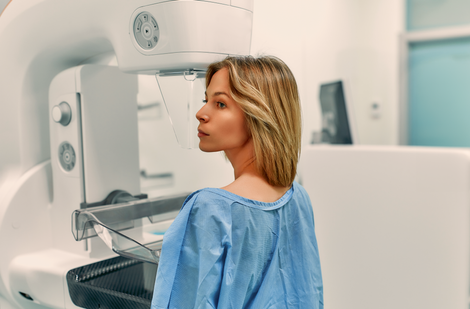Contrast agents enhance imaging accuracy in radiology, improving diagnosis of tumors, inflammation, and vascular changes.
Contrast agents can be used in radiology to increase diagnostic accuracy in certain examinations and inquiries. They help radiologists make pathological tissue changes, such as tumors, inflammation, or vascular changes, more visible. Before administering a contrast agent, the radiologist will carefully consider whether it is necessary, taking into account the patient's health condition and the type of imaging.
In the following article, we explain what contrast agents are, how they differ according to the procedure, and why we at aeon avoid using contrast agents.
What is a Contrast Agent?
Contrast agents are substances used in radiology to provide a more detailed representation of certain tissues and diseases. They absorb X-rays, influence the magnetic properties of tissues, or reflect ultrasound waves. However, not all radiological examinations require the use of contrast agents. In most cases, the use of contrast agents is safe. However, their use should be carefully considered as potentially life-threatening complications can occur.
Types of Contrast Agents
Contrast agents are distinguished by their method of administration and the type of contrast agent. Administration methods include:
- Oral Contrast Agents: These agents are ingested and are used primarily for imaging the abdomen and pelvis.
- Intravenous Injection: This involves injecting the contrast agent into a venous blood vessel, usually in the arm, allowing for rapid distribution throughout the body. This facilitates the imaging of blood vessels and internal organs.
- Intraarterial Injection: Contrast agents are administered through an artery, often used for vascular imaging in angiographic examinations via the femoral artery.
- Intrathecal Injection: Intrathecal administration involves injecting the contrast agent directly into the cerebrospinal fluid around the spinal cord and brain. This is used in rare cases for specific inquiries, such as detecting cerebrospinal fluid leaks.
- Rectal Contrast Agents: This method is used when the administration of contrast agents in the rectum or colon is required, particularly to visualize tumors, luminal narrowings, or inflammatory changes.
Contrast Agents in Imaging Procedures
Contrast Agents in X-ray and CT
Patients undergoing X-ray or computed tomography (CT) scans may receive radiographic contrast agents.
Iodinated Contrast Agents
Iodinated contrast agents are the most important for conventional radiographic diagnostics, as well as for fluoroscopy, angiography, and CT imaging. They can be administered in all the forms mentioned above. There are ionic and non-ionic forms.
Ionic contrast agents are salts that dissociate into ions in aqueous solution but are used less frequently due to their higher side effect profile.
Non-ionic contrast agents are now used more frequently due to their lower side effect profile.
Barium Sulfate Contrast Agents
For gastrointestinal tract examinations, contrast agents with high radiodensity, such as barium sulfate, are used because they absorb X-rays well.
Barium sulfate contrast agents have been used for many decades and have proven effective as oral agents for gastrointestinal examinations.
Contrast Agents in MRI
Gadolinium
Gadolinium-based contrast agents (GBCA) are molecular complexes containing the rare earth element gadolinium in chelate form. Free gadolinium ions are toxic and cannot be used directly as contrast agents. However, as a chelate, gadolinium is chemically bound and biocompatible. This also makes the gadolinium compound water-soluble and injectable.
There are two types of GBCAs: linear and macrocyclic contrast agents. While linear agents are considered less safe and are only approved by the European Medicines Agency in exceptional cases, macrocyclic agents are considered less risky. Several studies have shown that especially linear GBCAs are associated with an increased risk of gadolinium deposits in the brain.
Contrast Agents in Ultrasound
Contrast agents can also be used in ultrasound (sonography) to enhance the visualization of tissues. This is known as CEUS - contrast-enhanced ultrasound. The most commonly used ultrasound contrast agents consist of a solution containing tiny gas-filled microbubbles. These gas bubbles are vibrated by ultrasound waves, making them visible. Unlike contrast agents used in CT or MRI, ultrasound contrast agents can be exhaled, making them suitable for people with impaired kidney function or hyperthyroidism.
What Are the Possible Risks and Side Effects of Contrast Agents?
Contrast agents are generally considered safe, but in rare cases, allergic reactions, redness, itching, or nausea can occur. In exceptional cases, the administration of contrast agents can lead to kidney damage or hyperthyroidism.
It is important to distinguish that side effects can vary depending on the active ingredient, method of administration, and the patient's health condition.
Risks and Side Effects of CT Contrast Agents
Iodinated Contrast Agents can typically cause the following side effects:
- Metallic bitter taste in the mouth
- Nausea
- Vomiting
- Warm/cold sensation
- Itching
- Skin rash
- Hypothyroidism (hyperthyroidism)
- Hyperthyroidism (hypothyroidism)
- Kidney dysfunction
Life-threatening complications are very rare and include swelling of the mucous membranes in the throat, respiratory arrest, cardiac arrhythmias, or anaphylactic shock.
Risks and Side Effects of X-ray Contrast Agents
Barium Sulfate Contrast Agents can cause the following side effects:
- Constipation
- Diarrhea
- Bloating
- Nausea
- Vomiting
- Abdominal pain
Life-threatening complications are very rare and include pneumonia and peritonitis.
Risks and Side Effects of MRI Contrast Agents
Gadolinium-based contrast agents can cause the following side effects:
- Nausea
- Vomiting
- Warm/cold sensation
- Itching
- Skin rash
- Nephrogenic systemic fibrosis: A severe disease affecting internal organs, particularly the kidneys
Life-threatening complications are very rare and include swelling of the mucous membranes in the throat, respiratory arrest, cardiac arrhythmias, or anaphylactic shock.
What Are the Contraindications for the Use of Contrast Agents?
If there is a known or suspected intolerance to the contrast agent, its administration should be avoided. In any case, the benefits and risks should be weighed before administering a contrast agent.
Contraindications for Gadolinium
If kidney function is severely impaired (renal insufficiency) or if there are known contrast agent reactions, gadolinium should be avoided if possible. Although the administration of contrast agents during pregnancy is possible, it should only be done after careful consideration of necessity and medical indication. A retrospective study examining gadolinium exposure during pregnancy observed an increased incidence of rheumatologic and inflammatory skin diseases, similar to nephrogenic systemic fibrosis (NSF), in the gadolinium-exposed group.
Contraindications for Barium Sulfate
Barium sulfate should not be used as a contrast agent if there is a known intolerance to the contrast agent from previous examinations. Additionally, it should be avoided in cases of inflammatory bowel diseases, known or suspected bowel obstruction, and bowel perforation.
Contraindications for Iodinated Contrast Agents
In patients with, for example, impaired kidney function, hyperthyroidism, certain thyroid carcinomas, undiagnosed thyroid nodules, or hypersensitivity to iodinated contrast agents, the administration of iodinated contrast agents should be avoided or only done after careful consideration of risks and benefits. Although the administration of contrast agents during pregnancy is possible, it should only be done after careful consideration of necessity and medical indication.
Is MRI Contrast Agent Harmful to the Body?
The use of contrast agents helps radiologists interpret images and enables a more precise assessment of various changes in the body. Although they are considered exceptionally safe, gadolinium-based contrast agents (GBCA) can also have side effects. These include acute allergic reactions, nephrogenic systemic fibrosis (NSF), and gadolinium deposits in the body. Acute reactions after the administration of GBCAs are much rarer than with iodinated contrast agents.
It was long assumed that GBCAs are completely excreted through the kidneys in healthy individuals. However, studies have found that gadolinium can still be detected in some people months or years after administration, in the skin, bones, and even the brain. It is unclear, however, what effects, if any, the retention of gadolinium in the body has.
Why We Avoid Using Contrast Agents at aeon
Due to the high accuracy of MRI imaging, it allows for excellent early detection of a variety of diseases even without contrast agents. The avoidance of contrast agents combined with optimally tailored MRI sequences enables us to conduct examinations with maximum safety and high diagnostic value.
If a finding is detected during an examination, our experts will discuss with our clients the possibility of performing an MRI with contrast agents if necessary.
Conclusion
Contrast agents are used in radiology to improve the visibility of certain structures and tissues in the body. They can be used in various imaging procedures, such as X-rays, computed tomography (CT), magnetic resonance imaging (MRI), and ultrasound. Contrast agents are generally considered safe. However, in rare cases, side effects can occur, such as allergic reactions, nausea, and vomiting. In patients with impaired kidney function or other pre-existing conditions, the use of contrast agents must be carefully considered.






